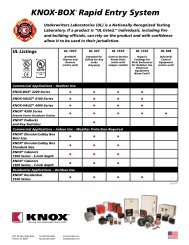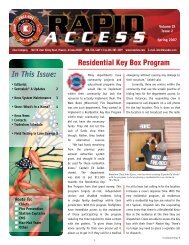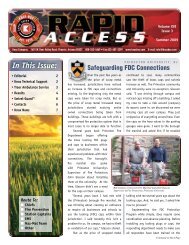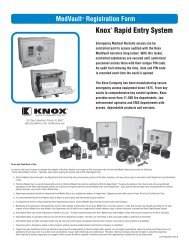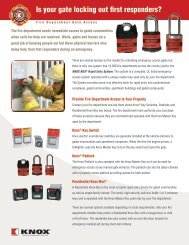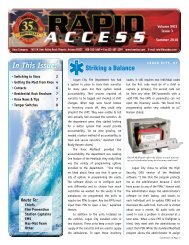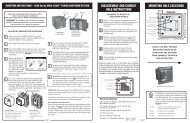In This Issue: - Knox Box
In This Issue: - Knox Box
In This Issue: - Knox Box
Create successful ePaper yourself
Turn your PDF publications into a flip-book with our unique Google optimized e-Paper software.
y Larry Pigg<br />
1. Identify the hazards.<br />
<strong>This</strong> will include an analysis of<br />
potential scenarios and threats. Is there<br />
an identified Haz-Mat route through your<br />
jurisdiction Do you have a major sporting<br />
complex After you identify the potential<br />
risks, focus on the likely threats. Once you<br />
have identified the potential hazards, and<br />
the likely events, you can develop a threat<br />
matrix that focuses on your vulnerabilities<br />
and resources you can rely on to meet<br />
the threat.<br />
2. Determine who is at Risk.<br />
Do you have retirement communities,<br />
state institutions, hospitals or any other<br />
special population groups that would<br />
be uniquely vulnerable Do you have<br />
a community evacuation plan in case<br />
of a Haz-Mat or weather related event<br />
Before you can make any decisions on<br />
how to respond, you must first be able<br />
to identify what groups are at a particular<br />
disadvantage should a catastrophic<br />
event occur.<br />
3. Evaluate the Risks.<br />
Now it’s time to take your data and<br />
correlate the vulnerabilities and the<br />
available assets. Risks are calculated by<br />
taking the events that pose the greatest<br />
danger and overlaying them on the<br />
expected or potential frequency. Experts<br />
suggest that the intent is not to cover<br />
every vulnerability, only those that pose<br />
the greatest risk to the community.<br />
“Vulnerability management is a matter of<br />
risk assessment as well as the ability to<br />
take a slice across an entire organization,”<br />
advises Mitchell Ashley, chief technology<br />
officer of StillSecure, a network security<br />
company.<br />
4. Develop an Action Plan.<br />
Review your current plans and modify<br />
them as needed. Once your vulnerabilities<br />
and assets have been identified, and the<br />
risks assessed, you have to decide what<br />
action you can take. What can be done<br />
to mitigate or completely block the<br />
risks Is the leadership team, including<br />
elected officials prepared to function at a<br />
high level under extreme circumstances<br />
Do you have multiple layers of trained<br />
personnel that can function for long<br />
periods of time Do you need additional<br />
training Can the most vulnerable systems<br />
be fixed immediately, or do you need<br />
modifications to both the infrastructure<br />
and the organization<br />
Solutions<br />
Once you have done your assessment<br />
and made the appropriate modifications<br />
to the system, document your findings<br />
and set up a program to regularly test<br />
the system and evaluate your progress.<br />
Once your system is completely ready,<br />
your people trained and your plans fully<br />
implemented, it is time to start the<br />
process over again. The following are <strong>Knox</strong><br />
solutions to common community risks:<br />
• Promote fire prevention and enforce<br />
the fire code. All of the model fire<br />
codes have provisions that allow the<br />
fire department to require emergency<br />
access.<br />
• Protect vulnerable FDC connections<br />
with <strong>Knox</strong> locking caps/ plugs. Fire<br />
sprinklers protect property and do save<br />
lives, sometimes those of firefighters.<br />
• Pass a local ordinance to require that all<br />
target structures have a key box in close<br />
proximity. Do the same for emergency<br />
elevator operation and power perimeter<br />
access gates.<br />
• Apply for a grant. The AFG program is<br />
proving to be a valuable tool. When<br />
used to support a local ordinance these<br />
grants can have a long-term positive<br />
impact on your community.<br />
• <strong>In</strong>stall a secure cabinet to store critical<br />
incident information or tactical plans.<br />
These could include Haz-Mat facilities,<br />
staging areas, schools or any other<br />
target occupancy that offer unique<br />
challenges and risks for emergency<br />
responders.<br />
Conclusion<br />
Proactive risk management is a vital<br />
part of the delivery of service for fire and<br />
police departments in the twenty-first<br />
century. Minimizing these risks will take<br />
on many forms. It will take a total effort<br />
of all of your available resources to meet<br />
the challenges. One of the lessons that<br />
we have learned over the past few years<br />
is that no fire department in America, no<br />
matter how big, can manage all the aspects<br />
of a major catastrophe by themselves.<br />
Use unconventional methods to meet<br />
emerging threats. Utilize volunteer groups<br />
like Citizen Corps and other community<br />
based citizen groups. Strengthen and<br />
update your mutual aid agreements. Look<br />
for areas of vulnerability and implement<br />
programs or legislative changes to meet<br />
current needs. The days of relying on the<br />
concepts of “faith and luck” alone are over.<br />
<strong>In</strong>dividuals and communities must analyze<br />
their surroundings, identify potential<br />
threats, and take positive proactive steps<br />
to lessen the damaging impact.<br />
5



